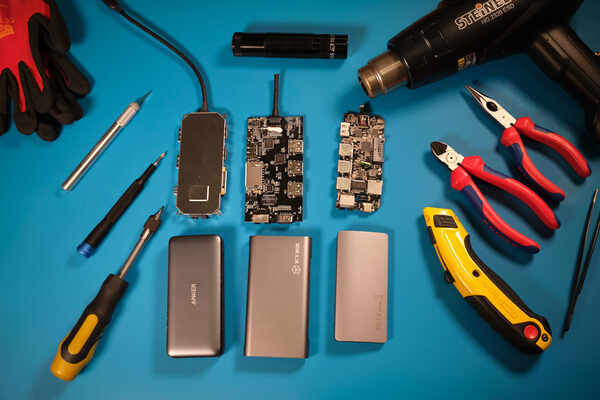I was looking for a new USB-c hub and came across this article. It’s an interesting write-up of what is on the inside of some popular options
USB-C and Thunderbolt docks/hubs are a huge mess.
Around a year ago I was searching for a solid single-cable solution for my M1 Max MacBook Pro to hook up to an external monitor, ethernet and peripherals - and best case a decent audio jack.
The MacBook supports Thunderbolt 4 so I thought I might as well go for a Thunderbolt 4 dock (as opposed to a “normal” USB-C dock), but oh boy.
First, there was the problem of display outputs. I thought I’d just get a dock with two DisplayPort ports. But there are a lot of differences. Some are DisplayPort 1.4, some only 1.2. And some use MST (multi stream transport) to support both ports; which macOS does not support. Thunderbolt 4 does support two distinct streams of DisplayPort though, so in theory docks could exist with two DisplayPort ports, each with their own dedicated stream/signal.
Long story short, there were basically no docks with these specifications. So it became clear to me early in the selection process that would need to act as a hub that has multiple Thunderbolt outputs, so I can simply use USB-C to DisplayPort cables. This seems to be the best solution anyways, as the dock doesn’t limit you in DisplayPort version or feature set this way.
So I looked for a Dock with 2-3 Thunderbolt outputs, Power Delivery, USB-A, gigabit ethernet and an audio jack.
There’s the Razer Thunderbolt 4 dock for example. Has all required ports, provides 90 watts of power to the computer and (at least in color “Mercury”), looks the part. Bought it, plugged it in, connected a display via USB-C to DisplayPort cable. So far, so good. USB-A seems to be working.
So, what are the problems? Well. Firstly, the ethernet controller is connected to the internal USB controller. This also means it shares bandwidth and when hammering the USB controller, doesn’t only mean bandwidth is throttled, but also that latency can be affected and spike seemingly randomly (like you’re on wifi). There are also reportedly some issues with USB ethernet when waking up from sleep, but this might be related to macOS. Anyways, use f* PCIe based ethernet in your 300,-€ dock!
Next problem was something I couldn’t believe got through QA. When audio starts playing via the audio jack, the right channel starts playing immediately, but the left channel starts after I’d say around a 200-300ms delay. This is VERY irritating, especially with headphones. As I said I couldn’t believe it so I tried other devices including Windows 10 and 11 notebooks, and they all showed the exact same issue with this dock.
I found out that the problem goes away or is at least reduced when you set audio output to 24-bit in Windows. That’s not how it works in macOS though (I know you can set something in some MIDI audio setting app, but that didn’t help). So you’re basically stuck. It’s so insane to me that this glaring and obvious issue went through QA.
Then I thought okay, it’s just Razer being Razer and ordered alternative docks. Turns out THEY ARE ALL THE SAME CRAP INSIDE. Sonnet Echo 11, i-tec whatever, Kensington. If it has a similar port layout to the Razer dock, it’s likely that it’s the exact same crap with the only difference being the odd USB-A port more or less and slightly different PD wattage.
There’s a highly praised 400,-€ dock from CalDigit, but availability was bad at the time.
I ended up getting an Anker dock for around 170,-€, which simply has 3 Thunderbolt 4 outputs and a single USB-A output. I connected a simple USB-A hub so I can connect keyboard, mouse and USB DAC and mic for audio. I use the Thunderbolt outputs for DisplayPort via USB-C and the Apple Thunderbolt (1) Gigabit Ethernet adapter plugged into an Apple Thunderbolt 2 to Thunderbolt 3 adapter, and that’s plugged into the dock. You wouldn’t believe that this abomination of adapter chaos works a million times better than this USB ethernet crap.
Now, this setup works but it’s super ugly and messy on the desk.
Nowadays I’m using some HP monitor with USB-C which has built-in ethernet and USB-A ports. It’s honestly not a great solution (and functionally worse than my solution above), but it’s simple and doesn’t clutter your desk with 3-4 different boxes and 10 cables.
Unbelievable.
So I’m not the only one pissed off. At least this.
What annoys me even more is that one of my monitors is capable of daisy chaining thunderbolt. But MacOS isn’t. It would be the perfect solution, but no. Apple doesn’t like it.
Don’t worry, I can’t get Windows 10 to daisy chain my work’s Viewsonic daisy chain-able displays either (they have a built in dock). Stuck plugging in one to USB-C and one to HDMI.
USB-C and Thunderbolt docks/hubs are a huge mess.
USB itself – as in, the entire
standardset of standards – is a huge mess. The people in charge of it totally lost the plot on what “universal” is supposed to mean somewhere around version 3.0. The whole point of USB was to replace a whole bunch of different types of cables with one kind of cable that you could plug in and know would do whatever you needed it to do. But now there are so many different speeds and Alternate Modes and various schemes for transmitting power that not only are we back to the Bad Old Days of having different cables with different capabilities and uses, but now it’s even worse because all the damn things look the same from the outside, so you can’t even tell which does what without resorting to using shit like this to query the device capabilities!!!I have one of these and it is amazing:
Highly recommend for a fixed workstation docking station.
Great that it works for you, but this dock has many of the same issues I’m describing in my post. Outputting to two displays uses MST, so it simply won’t work under macOS (except for cloning the image). Ethernet is internally connected via USB instead of PCIe.
Note that all USB 3.1/3.2/(whatever, fuck USB naming) docks have these problems, but Thunderbolt 4 docks can - in theory - do better.
A monitor with Ethernet? That sounds interesting.
Can you please give me the model name? Thanks!
Docking monitors are pretty common, must vendors should have them.
They are generally a bit shit, however - much like these docks
HP Z27k G3
It’s not Thunderbolt, “only” normal USB-C, but it works okay, especially considering the price.
Keep in mind that the daisy chaining feature is pretty useless with macOS, as, you guessed it, it uses MST (it has to in this case to be fair) which macOS doesn’t like.
You get 90 watts of power delivery, 4 USB ports and GbE.
The problem is that almost all electronics available online (not just on Amazon) are rebranded Chinese bargain bin garbage marked up by 10x and people think “it must be good because it’s expensive”.
Really your only option is to either accept that everything is disposable and will need to be replaced frequently, or to find the “good” brands and stick to them.
That last part is by design… it’s why a lot of this shit is perpetuated by the same parent company under a different name, to create a “hostile environment” to make it so you can’t shop around for cheaper prices.
All valid reasons, but the underlying of it all is that the USB consortium that comes up with these standards and fucked up the usb-c standard leaving us with this quagmire of cables and dangles. Remember the first USB-C cables? The ones that caught on fire? Or where USB 2.0 with USB-C connectors? Pepperidge Farm remembers
This comment is basically just a tl;dr of the OP
TL;DRs are valuable contributions!
Also, his last point is synthesizing a new argument that the situation is a deliberate confusopoly.
“Unfortunately, looking at the hardware information, … it’s another Realtek RTL8153 …”

This resonates so much with me.
I had a similar experience with dongles, but also with some hardware like screwdriver kits.
It seems like the amount of choice we get nowadays is inversely proportional to the quality of the products.
It can become excruciating to shop for the most basic items on Amazon, because most of them are just cheap shit.
That’s the price you pay for relocating so much stuff.
It also makes Amazon a lot less enticing to shop on. If I want cheap shit, I’d just as soon get it cheaper direct from China (Temu, AliExpress). If I want brand name products (IDK - do they even exist anymore?) I need to go to like Best Buy I guess.
Amazon is just Wish but more expensive. But even if you go to Best Buy or Microcenter, you can still end up with the same rebranded crap.
If I want brand name products (IDK - do they even exist anymore?) I need to go to like Best Buy I guess.
I find best buys store brand “insignia” to be a good middle ground for not being cheap garbage, and being something I can carry straight back and demand a refund if it’s crap
Just imagine how easy things would have been if these 3000$+ computers had the necessary ports built into them.
3 usb type-c and two type-A ports, hdmi out, sd card reader should be bare minimum. A 3.5mm headset jack and collapsible rj45 or very least rj45 to usb adapter should also be included on machines intended for professional use.
Edit: for those complaining about having to disconnect multiple cables, sure you can buy a hub or dock if you want ease of use. But that would still be possible on a machine with its own ports. You don’t have to have a working dock to actually use the machine.
Just imagine how easy things would have been if these 3000$+ computers had the necessary ports built into them.
That would only solve some problems. My typical problem of not wanting to wire up 6 or 7 cables every time I switch between home-office and office would still go unsolved. Just plugging in a hub that already has keyboard, mouse, headset, monitors, and preferably even power attached is very nice to be actually flexible with the setup (also when quickly moving to a conference room and back).
But… but then you’d have to make them 0.01mm thicker.
No thanks, I plug 2 cables into my MBP and get:
- Multiple USB-A/USB-C ports
- Ethernet
- 3 monitors
- Power
- Sound
- SD card reader
- And a few other things I don’t use
Contrast that with my old MBP that had “all the ports”, I’d have to plug multiple things in, I still had to use hubs, and it struggled to drive 2 monitors. No thanks.
You can use a thunderbolt hub if you want. The point is that with every other brand, you don’t have to.
My Latitude has 3 USB-A ports, micro-SD, RJ-45, HDMI, audio jack, Dell power connector, and a full-sized thunderbolt USB-C port that you can also use to charge your laptop while doing all the things that Apple’s mandatory USB-C ports do.
So now if I’m at my desk I can plug one cable just like you, in the same hub that you do. And if I’m on the go and need to plug something in… well let’s just say it’s a pleasure of mine to lord it over the Apple-only guys that I don’t need 300€'s worth of cable spaghetti to connect to the beamer in the meeting room.
I will never get how and why Apple shills defend the shit that Apple does. How does proving less functionality benefit ANYONE but Apple? This behavior is so obviously against your own interest! Like, get whatever laptop you want, I don’t care and I see that Apple does some things right. This isn’t one of them and there is zero objective reason to defend them for removing standard connectivity from their laptops.
I will never get how and why Apple shills defend the shit that Apple does.
They want the product because it looks fancy and they don’t know any better about the specs to realize it’s overpriced. Or they do know and don’t care because it’s a status symbol. Which is worse, really.
I mean the first iPhone couldn’t even use the music on the phone for ringtones. There were like 10 pre-loaded rings and that was it. Meanwhile my Windows smart phone could use any MP3 on the SD card (which could also be used to play music). But people were lining up around the block for the iPhone even though it was objectively worse that the other phones at the time. It was just shiny and didn’t require thinking to use, just blind acceptance.
3 usb type-c and two type-A ports, hdmi out, sd card reader should be bare minimum. A 3.5mm headset jack and collapsible rj45 or very least rj45 to usb adapter should also be included on machines intended for professional use.
Who decided that’s a work requirement? 2 usb c, 1 usb a, and hdmi is about all the average person needs for work use. Anything more than that and you should just get accessories. Usb hubs aren’t a new concept.
I miss the days where you could just buy something from Logitec or Hayes or Gravis or CH Products and know it was not garbage just because the brand could be trusted. Finding a trustable brand these days seems super hit or miss. You’ll get a great item and then the next one will be some cheap china garbage that dies in 4 months.
just because the brand could be trusted
You’ll take your $200+ gaming mouse that has a 90% chance to have a double click issue because we can save $0.02 per mouse by using cheaper switches, that’ll force you to get multiple replacements through warranty (if it hasn’t expired yet), and you’ll like it!
- Logitech
Meanwhile, my OG G502 mouse from 2013~ is still working perfectly almost 10 years later.
I’m confused why everybody calls these USB hubs – they aren’t hubs they are docking stations. A hub provides N USB ports so you can connect multiple. These provide other ports like ethernet, HDMI, etc. But do nothing if you actually want to plug more USB devices into your computer.
The best actual USB C hub I found is this:
https://www.cambrionix.com/products/thundersync3-c10
It is crazy expensive, and still doesn’t work that well, but it seems to be the best thing on the market. I still have to power cycle mine once a week or so because the connected devices stop being visible.
Now that’s a USB C hub.
I hate the way when you search for USB C hub on amazon you get a list of USB C dongles with ethernet and HDMI, a couple of A ports and 1 or maybe 2 C ports.
Far too many technological products of almost any kind are like this now. Often hiding behind complex and useless warranties (our new $6000 Carrier home HVAC device failed after 16 months – warranty requires us to remove and ship back!).
It’s all such a shit show.
draft - can we get a usbc community going on lemmy.world / lemmy like we have r/usbchardware (reddit.com/r/usbchardware) on reddit? thank you
Thank you, I love exactly these kind of dives. Realtek makes absolute trash, they just happen to make affordable trash. The DP to HDMI chip was interesting, given most of these dongles provide hdmi I assumed the main usb-c hub actually did HDMI protocol translation internally, or I think alt-mode has proper hdmi support?
I go through these pretty quick too, they don’t last long, I had good luck with the Startech dkt31chpdl and an anker which is an upgraded version of the one you “liked”.
Overall I’ve found they mostly die, I have a Lention that seems to be chugging along, as well as 2 Lionwei’s that haven’t given me trouble yet, but mostly I’ve found Caldigit thunderbolt does the job reliably and for more than 6 months at a time.
Alt-Mode HDMI stopped at 1.4b. Everything now is DisplayPort Alt-Mode to HDMI. The translation is simple enough it can be done passively and components can fit inside the connector, meaning it looks like a simple cable.
Drawbacks are you can’t get GSync, Freesync, or VRR. Also Nvidia’s drivers only output 2.0 Audio over DisplayPort, so no surround sound.
Til. Shame, but DP is much better anyway. That explains why I can rarely get more than 1080p out of those anyway, only have a few good ones that go to qwxga.
Hdmi is such a disaster of a standard, I wish they’d just make new versions a different connector running DP, everyone would be happy, though the 5 people using the ethernet support would be SOL.
HDMI has ethernet support?
I mean, technically:
https://thehometheaterdiy.com/hdmi-with-ethernet/
Never seen anyone use it before, but it’s there.
On YouTube I see guys make custom connectors for old ass computers with extinct connectors. Also as a child I made TV antennas out of paper clips. Cheap is king baby
The Dell D6000 actually works pretty well. I have it running two monitors, keyboard, mouse, Ethernet, USB-A microphone, and analog speakers via 3.5mm. Every once in a while I’ll need to reseat the cable if the HDMI-based monitor doesn’t wake up.
Can confirm, Dell’s docks work great because they just have to provide high-quality docks to their business customers (such as my company).
The only complaint I have is that some of their dock (dunno if it’s the 6000 series or other ones) use DisplayLink when you connect multiple monitors, which is a closed protocol with shoddy support on Linux (according to some colleagues it has gotten better, but YMMV). Everything else works has been working perfectly for years though.
Thanks for the tip. I have a random “Pluggable” brand docking station that works fine with Windows but not my Linux laptop, neither with Zorin or PopOS. I get nothing from either monitor and can’t get DisplayLink to properly install on either OS.
I will look into Dell. Do you know of an easy way to tell if DisplayLink is required? I’m looking at this one and don’t see it mentioned:
https://www.dell.com/en-us/shop/dell-dual-charge-dock-hd22q/apd/210-bexl/pc-accessories
It’s a pain in the ass with Dell. The one I have on my desk right now is a
K20A001, which works great, but I know the newer Dx000 series that our ICT department bought all use DisplayLink. However those seem to be explicitly mentioned on the spec sheet, so there’s hope that if it just says “DisplayPort” then no DisplayLink is involved. Maybe double-check google just to make sure, if it’s DisplayLink there should be people complaining about it.
As someone who enjoys a bit of practicality into everything…? I was tempted to buy one of those little tidbits for a “futureproof” feel onto everything I plugged the little bastards in.
Until I met the… kvm switch. It may not allow me to plug a billion different things into it… but damn. It really works.
I have 3 KVM switches, neither works with my CTRL keyboard neither with my gaming mouse. Sigh.
I’m thinking of building my own “dumb usb switch” as I have to plug, unplug all the time…
If yoi are looking for something good, Microsoft Surface Docks tends to be a solid yet underrated option that I rarely see people talk about, as their hardware design is usually exceptionally good.
Otherwise, I’d say Lenovo or Dell’s business lines, because corporate IT had to deploy so many of them that most issues would be ironed out at that point.
Yeah, but paying $300 for one is crazy for the average home user. If I am spending company dollars, then sure, there is a reason to go for the brand name. But for my home setup I want something between cheap and crazy expensive.
In your scenario, I would say the best option would be buying used enterprise stuff for your home setup if you want both quality and relatively low price.
I got UGreen. Working rock solid for about a year 9-5.
It has power pass through to charge the laptop.
They are cheap and reliable. Mine I’ve been using one for 2-3 years now.
Was the issue that he was getting knock offs through Amazon?
One of the ones he bought is sold on Apple’s website, so I don’t think so.
















